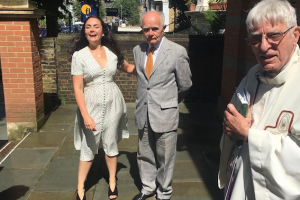Pope Benedict teaches on St Columban - a 'European saint'
The catechesis given by Pope Benedict XVI during the General Audience yesterday, was dedicated to "the holy Abbot Columban, the most famous Irishman of the early Middle Ages." "With good reason he can be called a "European" saint, because as monk, missionary and writer, he worked in several countries of Western Europe," the Pope said. "Along with the Irishmen of his time, he was aware of the cultural unity of Europe." Columban was born around the year 543, in the Province of Leinster, in southeast Ireland. At the age of about 20 he entered the monastery of Bangor on the northeastern part of the island, where he led "a life of prayer, aestheticism, and study," and where he was also ordained a priest. At almost 50 years of age, Columban left the island with 12 companions to engage in missionary work on the European continent. "We must, in fact, keep in mind," the Pope explained, "that the migration of people of the North and East had made entire Christianized regions fall back into paganism." Around the year 590, Columban and his companions landed on the Breton coast, where they were received with benevolence by the king of the Franks of Austrasia (present day France), who gave them the ancient Roman fortress of Annegray, all demolished and abandoned. After having rebuilt over the ruins, the monks began their work of re-evangelization. The Holy Father continued, saying: "the fame of those foreign religious, who, living on prayer and in great austerity, built houses and cultivated the earth, spread rapidly and attracted pilgrims and penitents. Above all, many young men asked to be received in the monastic community to live, like them, that exemplary life that renewed the cultivation of the earth and of souls." A second monastery was later founded in Luxeuil, which would later become the center of monastic and missionary radiation of Irish tradition on the European continent. A third monastery was erected at Fontaine. Columban lived at Luxeuil for almost 20 years. Here the saint wrote the "Regula Monachorum," that delineates the ideal image of the monk; the "Regula Coenobialis," a sort of penal code for infractions, with rather surprising punishments for modern sensitivity; and the "De Poenitentiarum Misura Taxanda," with which he introduced private and repeated confession and penance on the continent. It was called "tariffed" penance because of the proportion established between gravity of the sin and the type of penance imposed by the confessor. "This novelty awakened the suspicion of the bishops of the region, a suspicion that was translated into hostility when Columban had the courage to reprimand them openly for some of their practices." Intransigent as he was on every moral question, Columban even entered into conflict with King Theodoric, whom he had severely reprimanded for his adulterous relations. In the year 610, this was translated into a decree of expulsion from Luxeuil of Columban and all the monks of Irish origin. However, the ship ran aground a short distance from the beach and the captain, seeing in this a sign from heaven, gave up the enterprise and, out of fear of being cursed by God, took the monks back to dry land. The monks then began a new work of evangelization. They embarked on the Rhine and sailed up the river. After a first stop at Tuggen near the Lake of Zurich, they went around the region of Bregenz near Lake Costanza to evangelize the Germans. Shortly after, however, Columban -- because of political affairs not favorable to his work -- decided to cross the Alps with the majority of his disciples. Only a monk by the name of Gallus stayed behind; from his hermitage developed later the famous Abbey of St. Gall, in Switzerland. "Arriving in Italy, Columban met with a benevolent reception at the Lombard royal court, but he soon was faced with noteworthy difficulties. The life of the Church was lacerated by the Arian heresy still prevalent among the Lombards and by a schism that had removed the greater part of the Churches of northern Italy from communion with the Bishop of Rome. Columban inserted himself with authority into this context, writing a libel against Arianism and a letter to Boniface IV to convince him to take some decisive steps in view to re-establishing unity." In 612 or 613, the king of the Lombards assigned him some land in Bobbio, in the valley of Trebbia, and Columban founded a new monastery which later became a center of culture comparable to the famous one of Montecassino, where he died on November 23, 615. "St. Columban's message is centered on a firm call to conversion and detachment from the goods of the earth in view of our eternal heritage," the Holy Father mentioned at the end of the catechesis. "His austerity, however, was never an end in itself, but was only the means to open himself freely to the love of God and correspond with his whole being to the gifts received from him, thus reconstructing in himself the image of God and at the same time cultivating the earth and renewing human society." A man of great culture, Columban was "a tireless builder of monasteries as well as an intransigent penitential preacher, spending all his energy to nourish the Christian roots of Europe, which was being born. With his spiritual energy, with his faith, with his love for God and for his neighbor, he truly became one of the fathers of Europe: He shows us even today the roots from which our Europe can be reborn." Source: Fides


















